Raw Goat Milk Hard Cheese — Picture Tutorial
Recipe by Wardee Harmon and her mom, Martha Bisharat
This is the traditional Middle Eastern goat cheese. It is salty and yummy. It is best tasting when made from fresh goat’s milk. I’m not going to lie to you, though — not everyone likes this cheese. It is definitely an acquired taste. I’m one of those who love it. I gobbled it up as often as I could. Growing up, whenever we would get together with extended family, one of my aunts (usually Aunt Nina or Aunt Selma) would add some to the feast. We ate it for breakfast, lunch and dinner. There would be squares of it laid out. I never ate it on a sandwich or on anything else — I just alternated bites of it with the other delicious foods being served.
The process of making the goat’s cheese can easily take the whole day. You won’t be working most of the time, though, just waiting. You don’t want to rush it. I would encourage you to make sure your dishes are done because you’ll tie up your sink for hours — unless you’re one of the blessed who may have a laundry room sink or other sink to use for this process.
I’m not an expert at cheese making– I’ve made this cheese a half dozen times now. I am following in the footsteps of my talented and gifted mom, who learned how to make it from my Aunt Nina. So I’ll share what we do. If you have questions, please ask!
This recipe may be doubled or tripled successfully. Any more than that and you will have a hard time handling it. The pictures in the tutorial show the recipe doubled (using 2 gallons of raw goat milk).
The Ingredients.
- 1 gallon fresh, raw goat milk
- 20 drops of liquid rennet (available at a health food store)
1. Prepare a Press.
You will need to have a press of some sort. One way to do this is to use a cutting board. The cheese will lay on top of this, along with a tray of heavy objects (such as rocks or canned goods). If you wish, you can use another cutting board on top of the cheese, and then weight it down with a bucket full of sand or the tray full of heavy objects.
My dad gave me the following homemade cheese press last Christmas (2005). It consists of 2 cutting boards with holes in the corners, into which I insert bolts to connect them together. A wing nut is attached to the end of the corner bolt to tighten down the “press.”
This is 1 of the 2 14″ x 18″ plastic cutting boards. The red dots show you where my dad drilled 1/4″ holes in each corner, 1-1/2″ from each edge. The holes in this cutting board line up exactly with the holes in the other cutting board.

Through each corner, I insert a 3″ long, 3/16″ wide bolt. I also use 2 washers — one under the screw head of the bolt and the other under the wing nut that attaches to the free end of the bolt. I lay the entire unit down (both cutting boards screwed together loosely) over the sink, with the wing nuts facing up. Then when I put the cheese between the 2 cutting boards, I can tighten the wing nuts to bring the boards closer together, thereby acting as a press on the cheese.

A note about my press: It was the first one my dad made. He observed it in action. Since then, we have decided that it would be better if the cutting boards were smaller. Because the screws in the corners are so far away from the cheese in the middle between the boards, they don’t exert enough pressure on the cheese when tightened down. To counteract this, I put a weight (such as a bucket full of sand or a tray full of canned goods) on top of the cutting boards, directly over the cheese. So use this as a guide, but recognize that we are still figuring it out ourselves.
2. Heat the Milk.
In a pot of sufficient size (with a lid), heat the milk to lukewarm (86 degrees), enough to take the chill out. Remove from heat.
3. Add the Rennet.
Measure out the rennet into a bowl, stirring a little milk into it. Then pour all of it into the lukewarm milk. Cover and let this sit for 2-1/2 to 3 hours.
You will know it has been enough time when the whey is separating out and the solids have a yogurt-like consistency.
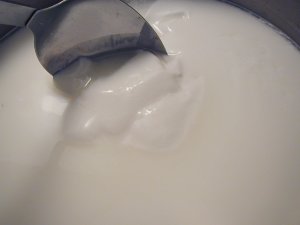
Uncover and let cool for 15 to 30 minutes.
4. Squeeze out Whey.
Pour the solidifying milk into a cloth drip bag, such as a pillow case. The cloth mesh should be fine enough for the whey to strain but no milk solids to escape.

It gets a little tricky here and you must work fast to keep your milk from spilling out into the sink. A firm twist to the cloth bag will control the contents. The whey will seem to be gushing out from all directions.

Continue squeezing out the whey until the remaining contents in the bag feel fairly solid. This can take time, so be patient. When it no longer feels like liquid, move it over in the sink and get the bottom layer of your press (one cutting board) set up over the sink.
Create a squared-up shape of the bag and its contents.

Add the other cutting board (if using) and weight to compress the cheese. Let set 2 hours or so.

After about 2 hours, the cheese is getting firm and close to the desired thickness of 1/2-inch.
The cheese is still moldable at this stage. It is a good time to square up your block. For example, where the drip cloth is twisted, it can create a hole in the center of the block of cheese. Removing the weights and handling only the outside of the cloth, untwist the cloth and lay it across the cheese.
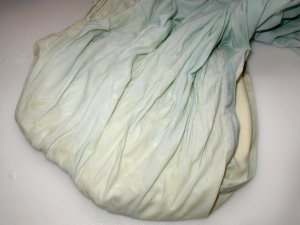
Stop pressing out the whey when the cheese reaches a thickness of 1/2-inch. If necessary, add more weight to continue pressing out the whey to achieve the 1/2-inch thickness. This period may take many hours; this is okay. When done, the cheese should be slightly bendable without breaking and slightly rubbery.
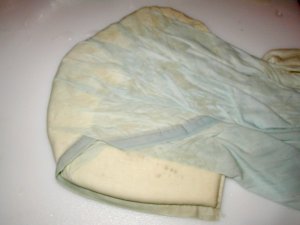
5. Cut the Cheese.
Remove the cheese from the cloth bag.
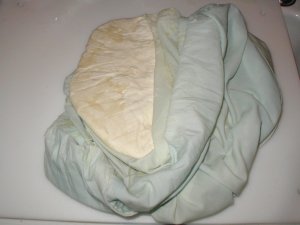
Cut cheese into 2-inch squares or 2-inch by 3-inch pieces.

6. Desiccate* the Cheese.
Desiccate — to thoroughly dry out.
Lay 2 layers of paper towels on a baking tray.

Place the pieces of cheese on the tray.
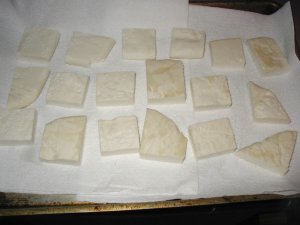
Salt liberally on both sides. Cover with another 2 layers of paper towel. Let sit for the next 3 days, changing the paper towel at least one time every day. Repeat the salting process daily. The cheese will continue to drain over these days. Room temperature is okay.
7. Sanitize the Cheese.
Bring a pot of filtered water to boil. Boil 2 to 3 pieces of cheese at a time for 45 seconds to 1 minute. Do not boil for more than 1 minute or the cheese will get soggy. Cool on cutting board.
8. Storage and Serving.
Store in airtight container in the refrigerator or freeze in ziploc bag. Before serving, soak the cheese in very cold water to extract some of the saltiness and then pat dry to serve. This cheese is delicious with pocket bread.
Other Cheesemaking Resources
We only recommend products and services we wholeheartedly endorse. This post may contain special links through which we earn a small commission if you make a purchase (though your price is the same).


Wow, that’s so incredible! That’s so much more ambitious than I am. I am just now beginning to think about making my own bread.
I admire all that you do for your family. It’s an inspiration.
I liked reading that tutorial, but I don’t think I’ll ever make the cheese. It does look like a lot of fun and work to make it. 😀
Wonderful instructions, dear Wardee. 🙂 I wish it were easier to get raw goat milk. I take it goat milk from Kroger will not work for this?
A few years ago I had a friend who was given raw goat milk once a week for many months for her baby. They always had extra and I ended up getting a gallon from her on about five occasions. We *loved* it.
I am listening to “Emma” on Audible.com and have been for the past two hours. We had Netflix send us the 1996 DVD and watched it Thursday, Friday, Saturday & Sunday! We’d not watched it, nor had I read it before that. I am enjoying another Jane Austen novel so very much, thanks to you. 😀
Have a super Monday, love, Robin
Robin,
I think you can use any goat milk. We prefer to use the fresh, raw goat’s milk.
What a blessing that you were able to get some extra goat’s milk for awhile.
I’m glad you’re enjoying Emma! Did you know that Jane Eyre is going to be on Masterpiece Theatre this coming Sunday evening and the next Sunday evening?
This may be a dumb question…but would this method work with raw cow’s milk?
Mindy – I don’t know for sure. I will ask my mom and let you know.
I’m with you on all the steps except the boiling proceedure at the end…if you want to maintain truly raw cheese, can you leave this step out. The good bacteria would still be intact and the enzymes left living…is there danger in not sanitizing the cheese?
Rachelle,
Thanks for pointing this out – I think you’re right! I don’t see what danger there would be in not sanitizing the cheese. And now that I think about it (it has been a couple years since posting this) I wonder why cheese should be sanitized anyway. The good bacteria in cheese is what makes it cheese! I would be tempted, next time I make this cheese, to leave off the last step, and see what happens. Thanks for stopping by –
And by the way, for you or anyone else who reads this – the flexible plastic cutting boards don’t work for a press. The flexibility is what works against them. I’d recommend using a wood cutting board, which won’t bend from the pressure of the bolts and wing nuts at the corners.
I’ve got 2 wooden flower presses that I’m going to repurpose for this cheese!
This sounds quite interesting-I want to try it, but as we don’t eat much salt, I’m afraid it would be too salty. Can the salt be cut down? My husband and I both have high blood pressure, so it’s imperative that we be able to do it with less salt.
We had goats about 15 years ago and drank the milk-it was great as long as it was fresh, but after a couple of days it go “goaty”. We are planning on getting a couple more next year to milk-Nubians I believe, since they are so sweet.
Shelley — You shouldn’t cut down the salt when making the cheese. However, you can soak the cheese in cold water for about 1/2 hour before eating to draw off the salt. I hope this helps. 🙂
FREEZE the cheese? Is that advisable? I’m sure it will ‘keep’, but the flavor and texture would be altered a lot!
Chris — Freezing this cheese doesn’t change the texture significantly. Certainly freezing isn’t good with all cheeses, but it seems to be fine with this one. I think that’s because there’s no stretch developed which could then be changed by freezing.
Great recipe. i have been milking our goat since Dec. and am looking for easy cheese recipes that my teens will not put their nose up or recipes that are easy and that i can freeze and are not too time comsuming or require a press (as i only have homemade stuff). is there a name for this cheese? seems I read it was Panir??? Thanks
Mary, no it isn’t Panir. I *believe* panir is cooked at a high heat, so definitely not raw. This is just Middle Eastern Goat Cheese – at least in my family!
Would i be able to wax this cheese and age it? and if so is there a desirable aging period i should be aware of? LAST THING, and if I am able to wax it and store would it need a cold environment or can i just leave it in the cupboard? sorry for all the questions.
Thank you for publishing this! I wanted to make a hard cheese that didn’t require culture, but I have rennet and didn’t want to do the vinegar or lemon juice route(because they don’t make hard cheeses).
I tried to make this cheese, it was squeaky and rubbery and the salt did not penetrate. Also, leaving it out for 3 days made it hard. So… I am wondering about salting it before drying it and only leaving it to dry for one day… any suggestions?
Hi Carie,
This cheese is supposed to end up quite hard. The salt is not likely to penetrate. For a softer cheese you may wish to try Chevre: https://traditionalcookingschool.com/2010/01/06/four-easy-raw-cheese-recipes/
Millie
Traditional Cooking School
Hi from the future 🙂 Loved this post.. I’m starting a pastured chicken farm, and I’m thinking about getting couple of goats to cut the long grass before chickens are moved.. So this might come in handy.. 😀 Still collecting ideas about what can I try if I do end up getting them. Don’t feel like growing them for meat.
In Serbia we have cow cheese similar to this one you made. It’s super salty and I love it, I just never had opportunity to try goat version 😀
Can this be done without the press?
Hi, Renee.
We’ve not tried it without pressing. It would be a softer cheese.
~Danielle, TCS Customer Success Team
Awesome post